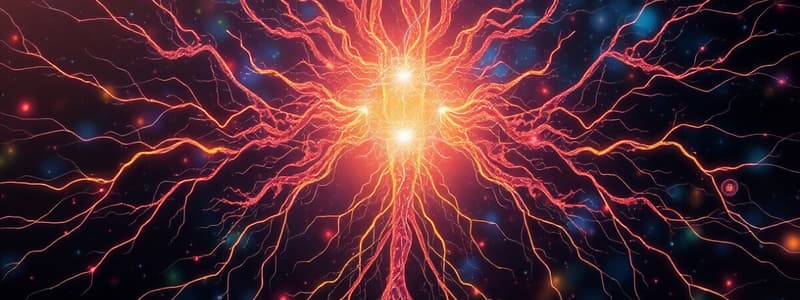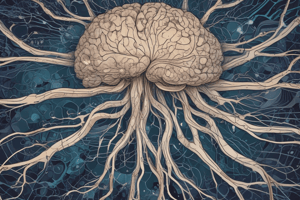Podcast
Questions and Answers
What are the main components of the Central Nervous System (CNS)?
What are the main components of the Central Nervous System (CNS)?
Which of the following best describes the function of neuroglia in the nervous system?
Which of the following best describes the function of neuroglia in the nervous system?
What is the role of the Na+/K+ pump in maintaining the resting membrane potential?
What is the role of the Na+/K+ pump in maintaining the resting membrane potential?
Which part of the neuron is responsible for receiving signals from other neurons?
Which part of the neuron is responsible for receiving signals from other neurons?
Signup and view all the answers
How do graded potentials arise in a neuron?
How do graded potentials arise in a neuron?
Signup and view all the answers
What type of division exists in the peripheral nervous system (PNS)?
What type of division exists in the peripheral nervous system (PNS)?
Signup and view all the answers
What is the purpose of the myelin sheath in the nervous system?
What is the purpose of the myelin sheath in the nervous system?
Signup and view all the answers
What characterizes the unique structure of neurons compared to other cells?
What characterizes the unique structure of neurons compared to other cells?
Signup and view all the answers
What is one key function of neuroglia in the CNS?
What is one key function of neuroglia in the CNS?
Signup and view all the answers
Neurons are capable of dividing and replacing themselves after injury.
Neurons are capable of dividing and replacing themselves after injury.
Signup and view all the answers
Name the two divisions of the peripheral nervous system.
Name the two divisions of the peripheral nervous system.
Signup and view all the answers
The ______ maintains the blood-brain barrier in the central nervous system.
The ______ maintains the blood-brain barrier in the central nervous system.
Signup and view all the answers
Match the following components of a neuron with their functions:
Match the following components of a neuron with their functions:
Signup and view all the answers
Which of the following correctly describes the resting membrane potential?
Which of the following correctly describes the resting membrane potential?
Signup and view all the answers
Graded potentials can lead to the generation of action potentials.
Graded potentials can lead to the generation of action potentials.
Signup and view all the answers
What is the primary role of the Na+/K+ pump in neurons?
What is the primary role of the Na+/K+ pump in neurons?
Signup and view all the answers
The ______ potential occurs in the dendrites and soma of a neuron.
The ______ potential occurs in the dendrites and soma of a neuron.
Signup and view all the answers
What distinguishes the axon from other parts of the neuron?
What distinguishes the axon from other parts of the neuron?
Signup and view all the answers
Which of the following is a characteristic of neurons?
Which of the following is a characteristic of neurons?
Signup and view all the answers
The peripheral nervous system consists of the brain and spinal cord.
The peripheral nervous system consists of the brain and spinal cord.
Signup and view all the answers
What is the role of neuroglia in the nervous system?
What is the role of neuroglia in the nervous system?
Signup and view all the answers
The _______ maintains the blood-brain barrier.
The _______ maintains the blood-brain barrier.
Signup and view all the answers
Match the following components of the nervous system with their functions:
Match the following components of the nervous system with their functions:
Signup and view all the answers
Which component of a neuron is responsible for transmitting signals away from the cell body?
Which component of a neuron is responsible for transmitting signals away from the cell body?
Signup and view all the answers
Graded potentials occur only in the axon of the neuron.
Graded potentials occur only in the axon of the neuron.
Signup and view all the answers
What maintains the resting membrane potential in neurons?
What maintains the resting membrane potential in neurons?
Signup and view all the answers
The ____ potential originates beyond the axon in a neuron.
The ____ potential originates beyond the axon in a neuron.
Signup and view all the answers
Which of the following descriptions is related to the function of the Na+/K+ pump?
Which of the following descriptions is related to the function of the Na+/K+ pump?
Signup and view all the answers
What is the main function of the grey matter in the spinal cord?
What is the main function of the grey matter in the spinal cord?
Signup and view all the answers
The spinal cord is approximately 75 cm long.
The spinal cord is approximately 75 cm long.
Signup and view all the answers
Name the three meningeal layers that surround the central nervous system.
Name the three meningeal layers that surround the central nervous system.
Signup and view all the answers
The __________ horn of the spinal cord contains motor neurons.
The __________ horn of the spinal cord contains motor neurons.
Signup and view all the answers
Match the regions of the spinal cord with their corresponding functions:
Match the regions of the spinal cord with their corresponding functions:
Signup and view all the answers
Which of the following describes a reflex arc?
Which of the following describes a reflex arc?
Signup and view all the answers
White matter primarily contains cell bodies and neural tissue.
White matter primarily contains cell bodies and neural tissue.
Signup and view all the answers
Identify the main components of the cerebellum.
Identify the main components of the cerebellum.
Signup and view all the answers
The __________ of the spinal cord contains myelin sheaths and axons.
The __________ of the spinal cord contains myelin sheaths and axons.
Signup and view all the answers
Which spinal segment corresponds to regions of the body that innervate the legs?
Which spinal segment corresponds to regions of the body that innervate the legs?
Signup and view all the answers
Study Notes
Nervous System Overview
- The nervous system is divided into the central nervous system (CNS) and the peripheral nervous system (PNS).
- The CNS is composed of the brain and spinal cord.
- The PNS is responsible for afferent (incoming) and efferent (outgoing) signals.
- The PNS efferent division is further divided into the somatic (voluntary) and autonomic (involuntary) systems.
- The enteric nervous system is responsible for processing information from the gut.
Neurons
- Neurons are specialized, long-lived cells with a high metabolic rate.
- Neurons cannot divide due to the lack of centrioles.
- Neurons contain a cell body (soma), dendrites, axons, telodendria, and axon terminals.
Neuroglia
- Neuroglia are the supporting cells of the nervous system.
- Neuroglia protect and separate neurons.
- Neuroglia in the CNS (glial cells) perform functions like maintaining the blood-brain barrier, repairing damaged neural tissue, providing a 3D framework for neurons, guiding neuron development, and forming the myelin sheath.
- Neuroglia in the PNS (Schwann cells) form the myelin sheath and regulate the microenvironment around neurons.
Membrane Resting Potential
- The resting membrane potential is a difference in the ionic composition of the extracellular fluid (ECF) and cytosol.
- The Na+/K+ pump actively maintains this difference.
- The membrane is more permeable to some ions than others.
- The potential is maintained by the membrane's selective permeability.
Altering the Membrane Potential
- Dendrites and soma are areas of the neurons where activation can lead to changes in the membrane potential.
- These changes are called local or graded potentials.
Graded Potential
- Graded potentials are localized changes in the membrane potential that vary in strength according to the intensity of the stimulus.
The Excitation Potential
- The excitation potential occurs in areas beyond the axon.
Nervous System Overview
- The nervous system consists of the central nervous system (CNS) and the peripheral nervous system (PNS).
- The CNS is comprised of the brain and spinal cord.
- The PNS is responsible for transmitting information to and from the CNS.
- The PNS afferent division carries sensory information to the CNS.
- The PNS efferent division carries motor commands from the CNS to the body.
- The efferent division is further divided into the somatic nervous system and the autonomic nervous system.
- The somatic nervous system controls voluntary movements.
- The autonomic nervous system controls involuntary functions like heart rate and digestion.
- The enteric nervous system controls the gastrointestinal tract.
Neurons
- Neurons are specialized cells that transmit information within the nervous system.
- They are long-lived and require a high metabolic rate.
- Neurons cannot divide because they lack centrioles.
- Neurons consist of a cell body, dendrites, axons, and telodendria.
- Axon terminals are the end points of axons.
Neuroglia
- Neuroglia are supporting cells that protect and separate neurons in the nervous system.
- Neuroglia are categorized differently depending on their location in the CNS or PNS.
- CNS neuroglia maintain the blood-brain barrier, repair damaged neural tissue, provide a 3D framework, guide neuron development, and provide myelin insulation.
- PNS neuroglia provide myelin insulation and regulate the neuron environment.
Membrane Resting Potential
- The membrane resting potential is a difference in ionic composition between the extracellular fluid (ECF) and cytosol.
- The sodium-potassium pump actively transports ions across the membrane, contributing to the resting potential.
- The cell membrane is selectively permeable to different ions.
- The maintenance of this membrane potential creates the resting potential.
- Passive ion channels allow the movement of ions across the membrane.
Altering the Membrane Potential
- Areas of the neuron, such as the dendrites and soma, can experience changes in membrane potential due to activation.
- These changes create local or graded potentials.
Stimulation
- Stimulation of a neuron can lead to changes in membrane potential.
Graded Potential
- Graded potentials are changes in membrane potential that are proportional to the strength of the stimulus.
Membrane States
- The membrane can exist in different states, including resting, stimulated, and depolarized.
Excitation Potential
- The excitation potential occurs in areas of the neuron beyond the axon.
Spinal Cord
- Approximately 45 cm long
- Contains gray and white matter
- Divided into cervical, thoracic, lumbar and sacral sections
- Surrounded by three layers (meninges): dura mater, arachnoid mater, and pia mater
- Gray matter contains neural tissue, neurons, cell bodies
- Posterior (dorsal) horn contains sensory neurons
- Anterior (ventral) horn contains motor neurons
- Lateral horn contains visceral neurons
- White matter contains neuroglia and myelin sheath encasing axons
- White matter is formed into columns moving up or down the cord
Nerve Plexuses
- Formed by the joining of ventral rami of spinal nerves
- Major plexuses include cervical, brachial, lumbar, and sacral plexuses
- Each plexus is responsible for innervating a specific region of the body
Dermatomes
- Regions innervated by neurons exiting at a specific spinal level
- Some slight differences between the distribution of sensory and motor function
- Overlap between adjacent segments
Reflex Arcs
- Sensory information enters the spinal cord via the posterior horn
- Motor information exits the spinal cord via the anterior horn
- Reflexes can occur at the level of the spinal cord
Studying That Suits You
Use AI to generate personalized quizzes and flashcards to suit your learning preferences.
Related Documents
Description
Test your knowledge on the key components and functions of the Central Nervous System (CNS) and the Peripheral Nervous System (PNS). This quiz covers topics such as neuroglia, resting membrane potential, and the structure of neurons. Expand your understanding of neuroscience fundamentals and prepare for further studies in this critical field.



